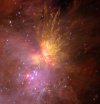Hey everyone,
In my research, there's a paper I've been working on alongside my research advisor and many others since May of last year. In particular, my contributions to the work lasted from May 2024 to June 2025. It has been officially submitted to Arkiv as of the 2nd of September - I forgot to bring it up earlier, but I'm happy to announce that I am the second author of the paper. Better late than never, right?
The research is, broadly speaking, discussing the origins of galactic cosmic rays, which are charged particles zipping through the universe at relativistic speeds - protons, electrons, etc. We don't have a good idea of where all cosmic rays come from - some come from supernova remnants, which are the left behind gas of high-mass stars. Others come from pulsars, ultracompact corpses of dead massive stars that emit beams of radiation at their poles. However, again, we don't have the full picture. Recent research has suggested that young, massive star clusters (specifically, those under 3 million years old) may also be responsible for producing cosmic rays.
That brings us to the young star-forming region DR21, located in the constellation of Cygnus, which we picked for our analysis due to its very strong gamma-ray emission (which we used to conduct our analysis). Interestingly enough, we found that DR21 is not only a very young and massive region containing stellar bipolar outflows (indicating that it is an active region of star formation) it's also a brand new type of object that has only been classified very recently: A explosive dispersal outflow (EDO). Imagery from these objects is absolutely stunning. Here's an example of one, known as Orion BN/KL, which is located in the Orion Nebula. Notice the "streamers" extending from a common origin, presumably in the center of the region. These objects are partially defined by this sort of shape, radial jets that don't seem to be polar in origin, extending in all directions (Credit: James Webb Space Telescope):

Interestingly enough, our research suggests that these kinds of objects may also be responsible for high-energy cosmic ray acceleration. It's not entirely known what causes these incredibly beautiful objects to exist just yet, but some theories suggest that cataclysmic collisions between high-mass stars in binary star systems may be responsible. As far as we can tell, though, they're very rare - only about five or six are really known.
Here is the link to the Arkiv page. You can access the pdf of the paper on the right side of the screen, if you'd like to read it. I'd be happy to answer any questions about it - especially those about our methodology, which I won't go into in this post unless it's asked of me, because it's quite a bit of an explanation. I'd love to hear anyone's thoughts who are interested!
In my research, there's a paper I've been working on alongside my research advisor and many others since May of last year. In particular, my contributions to the work lasted from May 2024 to June 2025. It has been officially submitted to Arkiv as of the 2nd of September - I forgot to bring it up earlier, but I'm happy to announce that I am the second author of the paper. Better late than never, right?
The research is, broadly speaking, discussing the origins of galactic cosmic rays, which are charged particles zipping through the universe at relativistic speeds - protons, electrons, etc. We don't have a good idea of where all cosmic rays come from - some come from supernova remnants, which are the left behind gas of high-mass stars. Others come from pulsars, ultracompact corpses of dead massive stars that emit beams of radiation at their poles. However, again, we don't have the full picture. Recent research has suggested that young, massive star clusters (specifically, those under 3 million years old) may also be responsible for producing cosmic rays.
That brings us to the young star-forming region DR21, located in the constellation of Cygnus, which we picked for our analysis due to its very strong gamma-ray emission (which we used to conduct our analysis). Interestingly enough, we found that DR21 is not only a very young and massive region containing stellar bipolar outflows (indicating that it is an active region of star formation) it's also a brand new type of object that has only been classified very recently: A explosive dispersal outflow (EDO). Imagery from these objects is absolutely stunning. Here's an example of one, known as Orion BN/KL, which is located in the Orion Nebula. Notice the "streamers" extending from a common origin, presumably in the center of the region. These objects are partially defined by this sort of shape, radial jets that don't seem to be polar in origin, extending in all directions (Credit: James Webb Space Telescope):

Interestingly enough, our research suggests that these kinds of objects may also be responsible for high-energy cosmic ray acceleration. It's not entirely known what causes these incredibly beautiful objects to exist just yet, but some theories suggest that cataclysmic collisions between high-mass stars in binary star systems may be responsible. As far as we can tell, though, they're very rare - only about five or six are really known.
Here is the link to the Arkiv page. You can access the pdf of the paper on the right side of the screen, if you'd like to read it. I'd be happy to answer any questions about it - especially those about our methodology, which I won't go into in this post unless it's asked of me, because it's quite a bit of an explanation. I'd love to hear anyone's thoughts who are interested!
Last edited:
